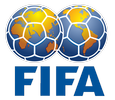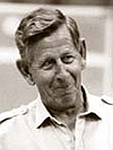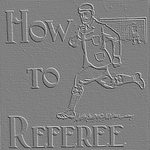 This Video from the... Ken Aston Referee Society -
This Video from the... Ken Aston Referee Society -
 Channel Channel

To recognize a correct goal kick and how to
deal with any infringements.
1. Introduction:
2. Procedure:
3. Infringements/Sanctions:
4. Action by Referee and Assistant Referee:
... including positioning:
Questions & Answers
|
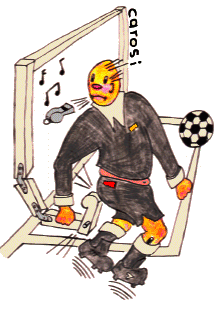 |
1. Introduction:
There are three possible
decisions when the ball passes over the goal line. (The goal
line is the line between the corner flags at the ends of the
field of play).
 - Goal kick - If the ball was last touched by an attacking
player and a goal was not scored
- Goal kick - If the ball was last touched by an attacking
player and a goal was not scored
 - Corner kick - If the ball was last touched by a defending
player and a goal was not scored
- Corner kick - If the ball was last touched by a defending
player and a goal was not scored
 - Place kick - If a goal is scored (i.e. during play, the whole
of the ball crosses the goal line between the goal posts.
- Place kick - If a goal is scored (i.e. during play, the whole
of the ball crosses the goal line between the goal posts. |
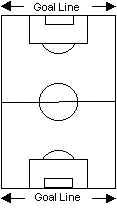 |
A goal kick is one method of restarting play when the ball has left the
field of play and has traveled beyond the boundary lines.
Players from either team cannot be offside directly from a goal kick. In
other words, a player cannot be offside if he receives the ball directly
from a goal kick taken by a player of his own team (or a throw-in or a
corner kick).
A goal may be scored directly into the opponent’s goal from a goal kick.
It would take some kick to do this!!!!
You cannot score a goal in your own goal direct from taking a goal kick
in your penalty area. Daft as it may seem - as a player - I have
actually seen this done. A defending colleague of mine (Dear Colin)
decided that he would take a quick goal kick. Just as he was about to
pass the ball to a team member on the edge of the penalty area, an
attacker quickly anticipated Colin's intention. Colin then quickly
decided that he would then kick the ball to another colleague who was
standing on the opposite corner of the penalty area. In doing so, Colin
got his legs tangled beneath him and actually kicked the ball directly
onto his goal. The Referee took a few moments to decide that the goal
kick had to be taken again - because the ball had not actually left the
penalty area.
During the taking of a goal kick, if the ball leaves the penalty area,
and is then promptly blown back into the goal kicker's own goal, a
corner kick must be awarded to the opposing team - because the ball did
come into play by leaving the penalty area and the goal kicker was the
last person to touch the ball. You cannot score a own-goal directly from
a goal kick.
A goal kick is awarded when:
 - The whole of the ball, having last touched a player of the attacking
team, passes over the goal line, either on the ground or in the air, and
a goal is not scored in accordance with Law 10 (Method of Scoring).
Beware when the ball is crossed over by an attacking player from a wide
position near the touchline, and it crosses over the goal line, out of
play in flight, and then bends back into play - a goal kick must be
awarded because the ball initially went out of play over the goal line.
- The whole of the ball, having last touched a player of the attacking
team, passes over the goal line, either on the ground or in the air, and
a goal is not scored in accordance with Law 10 (Method of Scoring).
Beware when the ball is crossed over by an attacking player from a wide
position near the touchline, and it crosses over the goal line, out of
play in flight, and then bends back into play - a goal kick must be
awarded because the ball initially went out of play over the goal line.
2. Procedure:
In an effort to speed up the game during the taking of a goal kick, a
player of the defending team can kick the ball from any point within the
goal area. In other words, if an attacking player last touched the ball
and it crosses the goal line to the right of the right hand goalpost,
then the resulting goal kick can be taken on the left hand side of the
goal area (or any other part of the goal area).
 -
The ball must be placed so that it touches the ground within the goal
area, including the lines which enclose it. The outer edge of the ball
could extend beyond or outside the goal area itself and still meet this
requirement so long as it does not break the plane of the goal area
boundary lines.
-
The ball must be placed so that it touches the ground within the goal
area, including the lines which enclose it. The outer edge of the ball
could extend beyond or outside the goal area itself and still meet this
requirement so long as it does not break the plane of the goal area
boundary lines.
| OK |
OK |
Not OK |
OK |
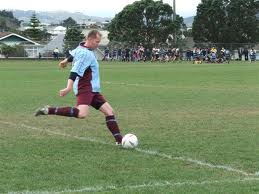 |
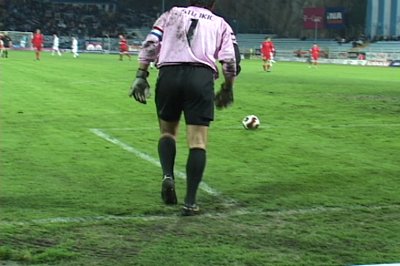 |
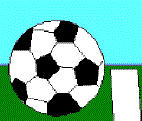 |
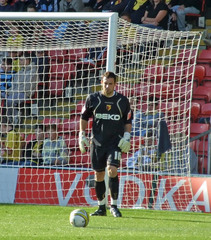 |
|
Inside Goal Area |
Inside Goal Area |
Outside Goal Area |
Inside Goal Area |
The ball only leaves any area of the
field of play...
when it has passed wholly over one of the boundary lines
that encompass that particular area.
 - Opponents must remain outside the penalty area until the ball is in
play (the ball is in play as soon as it leaves the penalty area).
Attackers are not permitted to run across or into the penalty area to
intercept the ball, until the ball has left the penalty area (if this
happens, then the goal kick must be retaken.)
- Opponents must remain outside the penalty area until the ball is in
play (the ball is in play as soon as it leaves the penalty area).
Attackers are not permitted to run across or into the penalty area to
intercept the ball, until the ball has left the penalty area (if this
happens, then the goal kick must be retaken.)
 - The kicker does not play the ball a second time until it has touched
another player.
- The kicker does not play the ball a second time until it has touched
another player.
 - The ball is in play when it is kicked directly beyond the penalty
area.
- The ball is in play when it is kicked directly beyond the penalty
area.
 - The ball must be stationary.
- The ball must be stationary.
 - A player of the team awarded the goal kick must take the goal kick.
- A player of the team awarded the goal kick must take the goal kick.
In other words, a member of
the opposition cannot take the goal kick.
3. Infringements/Sanctions:
If the ball is not kicked directly
into play beyond the penalty area:
 - The goal kick must be retaken
- The goal kick must be retaken
Goal kick taken by a player
other than the goalkeeper
If, after the ball is in play, the
kicker touches the ball a second time (except with his hands)
before it
has touched another player:
 - An indirect free kick is awarded to the opposing team, the kick to be
taken from the place where the infringement occurred
- An indirect free kick is awarded to the opposing team, the kick to be
taken from the place where the infringement occurred
If, after the ball is in play, the kicker deliberately handles the ball
before it has touched another player:
 - A direct free kick is awarded to the opposing team, the kick to be
taken from the place where the infringement occurred
- A direct free kick is awarded to the opposing team, the kick to be
taken from the place where the infringement occurred
 - A penalty kick is awarded if the infringement occurred inside the
kicker's penalty area
- A penalty kick is awarded if the infringement occurred inside the
kicker's penalty area
Goal kick taken by the goalkeeper
If, after the ball is in play,
the
goalkeeper touches the ball a second time (except with his hands)
before
it has touched another player:
 - An indirect free kick is awarded to the opposing team, the kick to be
taken from the place where the infringement occurred
- An indirect free kick is awarded to the opposing team, the kick to be
taken from the place where the infringement occurred
If, after the ball is in play,
the
goalkeeper deliberately handles the ball before it has touched another
player:
 - A direct free kick is awarded to the opposing team if the infringement
occurred outside the goalkeeper's penalty area, the kick to be taken
from the place where the infringement occurred
- A direct free kick is awarded to the opposing team if the infringement
occurred outside the goalkeeper's penalty area, the kick to be taken
from the place where the infringement occurred
 - An indirect free kick is awarded to the opposing team if the
infringement occurred inside the goalkeeper's penalty area, the kick to
be taken from the place where the infringement occurred.
- An indirect free kick is awarded to the opposing team if the
infringement occurred inside the goalkeeper's penalty area, the kick to
be taken from the place where the infringement occurred.
One way that this could
happen is if during the taking of a goal kick, the ball is lofted up
into the air, travels outside of the penalty area (it is then deemed to
be in play) and is then blown back into the penalty area without being
touched by another player. If the goalkeeper then touches it with his
hands you must award an indirect free kick, and not a penalty. Daft as
it seems, I have actually seen this happen during a game played in very
blustery conditions.
Another way this daft law
could happen, is for the ball to deflect back off the Referee who is
standing outside of the penalty area when the goal kick is taken!
For any other infringement of this
Law:
 - The kick is retaken (For example - during the taking of a goal kick,
an attacker cuts across the penalty area before the ball has left the
penalty area, and intercepts the ball by making a challenge on a
defender who is outside of the penalty area with the ball.) The Referee
should advise the attacker about the breach of this Law. Defenders can
take up any position that they want either inside or outside of the area
during the taking of a goal kick; but opponents must remain outside of
the penalty area until the ball leaves the penalty area.
- The kick is retaken (For example - during the taking of a goal kick,
an attacker cuts across the penalty area before the ball has left the
penalty area, and intercepts the ball by making a challenge on a
defender who is outside of the penalty area with the ball.) The Referee
should advise the attacker about the breach of this Law. Defenders can
take up any position that they want either inside or outside of the area
during the taking of a goal kick; but opponents must remain outside of
the penalty area until the ball leaves the penalty area.
 - If a player taking a goal kick, kicks the ball slightly backwards and
the ball then leaves the penalty area and crosses over the goal line
between the player's penalty area and the corner flag - the a corner
must be awarded. Because the ball has traveled outside of the penalty
area, it is deemed in play. If it then travels over the player's own
goal line it must be a corner (as the ball was last touched by the
defending player himself).
- If a player taking a goal kick, kicks the ball slightly backwards and
the ball then leaves the penalty area and crosses over the goal line
between the player's penalty area and the corner flag - the a corner
must be awarded. Because the ball has traveled outside of the penalty
area, it is deemed in play. If it then travels over the player's own
goal line it must be a corner (as the ball was last touched by the
defending player himself).
 - Conversely, if a player taking a goal kick kicks the ball slightly
backwards and the ball does not leave the penalty area and then crosses
the player's goal line inside his penalty area - then the goal kick must
be retaken.
- Conversely, if a player taking a goal kick kicks the ball slightly
backwards and the ball does not leave the penalty area and then crosses
the player's goal line inside his penalty area - then the goal kick must
be retaken.
Because the ball had not traveled outside of the penalty area, it is
deemed not yet in play. The goal kick must therefore be retaken.
 - And again as a reminder - a goal may be scored directly from a goal
kick, but only against the opposing team. In other words, a goal is not
allowed if you take a goal kick, in your own penalty area and the ball
is then blown directly back into your own goal after leaving your
penalty area. A corner kick is to be awarded to the opposition if this
ever happens!!!!!!!
- And again as a reminder - a goal may be scored directly from a goal
kick, but only against the opposing team. In other words, a goal is not
allowed if you take a goal kick, in your own penalty area and the ball
is then blown directly back into your own goal after leaving your
penalty area. A corner kick is to be awarded to the opposition if this
ever happens!!!!!!!
 -
If a defender takes a goal kick, and kicks it to his goalkeeper who is
just outside of his penalty area, and the goalkeeper then dribbles the
ball back into his penalty area and picks the ball up, you must award an
indirect free kick to the opposing team. The goalkeeper has
circumnavigated the 'back-pass' law by ignoring the spirit of the Law.
-
If a defender takes a goal kick, and kicks it to his goalkeeper who is
just outside of his penalty area, and the goalkeeper then dribbles the
ball back into his penalty area and picks the ball up, you must award an
indirect free kick to the opposing team. The goalkeeper has
circumnavigated the 'back-pass' law by ignoring the spirit of the Law.
 -
A goal kick is awarded when the ball enters the goal directly from an
indirect free kick taken by an opposing player.
-
A goal kick is awarded when the ball enters the goal directly from an
indirect free kick taken by an opposing player.
 -
A goal kick is awarded if the ball enters the goal directly from a throw
in taken by the opposing team.
-
A goal kick is awarded if the ball enters the goal directly from a throw
in taken by the opposing team.
 -
A corner kick is awarded to the opposing team if the ball enters the
thrower's own goal directly from his own throw in.
-
A corner kick is awarded to the opposing team if the ball enters the
thrower's own goal directly from his own throw in.
 -
If during the taking of a goal kick, one team continually plays the ball
before it leaves the penalty area, the Referee should penalize the
offenders for time wasting.
-
If during the taking of a goal kick, one team continually plays the ball
before it leaves the penalty area, the Referee should penalize the
offenders for time wasting.
 -
If the ball stops rolling before it leaves the penalty area, the goal
kick must be retaken.
-
If the ball stops rolling before it leaves the penalty area, the goal
kick must be retaken.
Time-wasting by the team taking the goal kick.
If upon being awarded a goal kick, the defending team
blatantly wastes time by placing the ball within the goal area in
preparation for the restart and then subsequently moving it
unnecessarily to another location within the goal area. This can be
deemed as time wasting.
When the ball has traveled some distance behind the goal, the
winning goalkeeper takes an age to collect a ball for the goal kick.
This can be deemed as time wasting. This usually happens when towards
the end of the game.
The Referee should firstly warn the culprit about his time wasting
tactics.
If this continues, the Referee should caution the player
concerned - for delaying the restart of play.
4. Action by Referee and Assistant
Referee:
The Referee will take the
following actions during and after a goal kick has been awarded:
 - The Referee should signal the award of a goal kick by pointing an
outstretched, slightly downward arm towards the goal area - and hold
this signal for about 5 seconds. This will demonstrate your decision to
all players.
- The Referee should signal the award of a goal kick by pointing an
outstretched, slightly downward arm towards the goal area - and hold
this signal for about 5 seconds. This will demonstrate your decision to
all players.
 - You do not necessarily have to blow your whistle when awarding each
goal kick. You only need to blow the whistle if players are in any doubt
as to whether you have decided that the ball has traveled out of play
over the goal line.
- You do not necessarily have to blow your whistle when awarding each
goal kick. You only need to blow the whistle if players are in any doubt
as to whether you have decided that the ball has traveled out of play
over the goal line.
 - Once you have indicated a goal kick, start moving backwards to a new
position near the center of the pitch to observe any fouls in the drop
zone, when the goalkeeper takes the goal kick. Be aware also, of fouls
committed whilst the ball is still in air following the taking of a goal
kick. Try and position yourself to allow a sideways view of players
contesting for the ball delivered from a goal kick. You soon learn just
how far an individual goalkeeper can kick the ball during a goal kick.
Do not stand on the center spot - move out towards the touchline to
enable a good panoramic view of the drop zone. (The drop zone is where
you think the ball will be delivered during a goal kick.)
- Once you have indicated a goal kick, start moving backwards to a new
position near the center of the pitch to observe any fouls in the drop
zone, when the goalkeeper takes the goal kick. Be aware also, of fouls
committed whilst the ball is still in air following the taking of a goal
kick. Try and position yourself to allow a sideways view of players
contesting for the ball delivered from a goal kick. You soon learn just
how far an individual goalkeeper can kick the ball during a goal kick.
Do not stand on the center spot - move out towards the touchline to
enable a good panoramic view of the drop zone. (The drop zone is where
you think the ball will be delivered during a goal kick.)
 - . This is one of the commonest
mistakes made by new Referees. Keep your eyes on the ball at all times.
It only takes a second for the goalkeeper to take a goal kick, and an
attacker then illegally and quickly enters the penalty area, gains
possession of the ball before it has left the penalty area and scores a
goal - and all done when you (the Referee) are walking away with your
back to the ball!!
- . This is one of the commonest
mistakes made by new Referees. Keep your eyes on the ball at all times.
It only takes a second for the goalkeeper to take a goal kick, and an
attacker then illegally and quickly enters the penalty area, gains
possession of the ball before it has left the penalty area and scores a
goal - and all done when you (the Referee) are walking away with your
back to the ball!!
The Assistant Referee will take
the following actions to signal to the Referee
that the ball has passed
over the goal line for a goal kick,
and to check that the goalkeeper
completes the goal kick correctly:
 - To signal a goal kick, stand sideways to the field of play and raise
an outstretched flag 90 degrees out from the body and towards the field
of play.
- To signal a goal kick, stand sideways to the field of play and raise
an outstretched flag 90 degrees out from the body and towards the field
of play.
 - Or use body language by facing sideways to the field of play, towards
the centerline, with your flag pointing down your leg. If there is any
dispute between players as to whether the ball has passed over the goal
line or not - the Assistant Referee should use the previous flag method.
- Or use body language by facing sideways to the field of play, towards
the centerline, with your flag pointing down your leg. If there is any
dispute between players as to whether the ball has passed over the goal
line or not - the Assistant Referee should use the previous flag method.
 - The Assistant Referee will check that the goalkeeper has placed the
ball inside the goal area before moving swiftly to take up a position
alongside the second last defender to observe any off sides following
the taking of the goal kick. Common sense dictates that the Assistant
Referee cannot be in two places at the same time. He should periodically
check the correct positioning of the ball during a goal kick, but he
should concentrate on the more important aspect of offside.
- The Assistant Referee will check that the goalkeeper has placed the
ball inside the goal area before moving swiftly to take up a position
alongside the second last defender to observe any off sides following
the taking of the goal kick. Common sense dictates that the Assistant
Referee cannot be in two places at the same time. He should periodically
check the correct positioning of the ball during a goal kick, but he
should concentrate on the more important aspect of offside.
 - The Assistant Referee and/or the Referee will check to see that the
ball has traveled outside the penalty area before another player touches
it.
- The Assistant Referee and/or the Referee will check to see that the
ball has traveled outside the penalty area before another player touches
it.
 - As soon as the Referee has indicated a goal kick, he should
start moving backwards to a new position near the center of the
field of play, in readiness to observe any fouls in the drop
zone when the goal kick is being taken.
- As soon as the Referee has indicated a goal kick, he should
start moving backwards to a new position near the center of the
field of play, in readiness to observe any fouls in the drop
zone when the goal kick is being taken.
 -
The Referee should look out for fouls committed whilst the ball
is still in air following the taking of a goal kick. Referees
should aim to position themselves to allow a sideways view of
the players contesting for the ball as it is being delivered
from the goal kick. Referees will need to anticipate just how
far an individual goalkeeper can kick the ball during a goal
kick.
-
The Referee should look out for fouls committed whilst the ball
is still in air following the taking of a goal kick. Referees
should aim to position themselves to allow a sideways view of
the players contesting for the ball as it is being delivered
from the goal kick. Referees will need to anticipate just how
far an individual goalkeeper can kick the ball during a goal
kick.
 -
Referees should never turn their back on the active players
before a goal kick has been taken - this is a common mistake
made by new Referees. The Referee must keep his eyes on the ball
at all times during the taking of a goal kick. It only takes a
fraction of a second (whilst the Referee has his back turned)
for the goalkeeper to take a goal kick, and an attacker then
illegally enters the penalty area, gains possession of the ball
before it has left the penalty area and scores a goal - and all
done when the Referee is walking away and looking in the
opposite direction!!
-
Referees should never turn their back on the active players
before a goal kick has been taken - this is a common mistake
made by new Referees. The Referee must keep his eyes on the ball
at all times during the taking of a goal kick. It only takes a
fraction of a second (whilst the Referee has his back turned)
for the goalkeeper to take a goal kick, and an attacker then
illegally enters the penalty area, gains possession of the ball
before it has left the penalty area and scores a goal - and all
done when the Referee is walking away and looking in the
opposite direction!!
 -
The Assistant Referee nearest to the respective goal should
signal to the Referee when the ball has passed over the goal
line for a goal kick, and check that the goalkeeper completes
the goal kick correctly. The Assistant Referee should position
himself slightly up the touchline from the corner flag, adjacent
to the level of the goal area line (see AR position, top right
in Fig. 4). The Assistant Referee should stand sideways to the
field of play (facing up towards the half way line) and raise
outstretched flag 90 degrees out horizontally from the body and
towards the goal.
-
The Assistant Referee nearest to the respective goal should
signal to the Referee when the ball has passed over the goal
line for a goal kick, and check that the goalkeeper completes
the goal kick correctly. The Assistant Referee should position
himself slightly up the touchline from the corner flag, adjacent
to the level of the goal area line (see AR position, top right
in Fig. 4). The Assistant Referee should stand sideways to the
field of play (facing up towards the half way line) and raise
outstretched flag 90 degrees out horizontally from the body and
towards the goal.
 -
The Assistant Referee can also use body language (depending on
the Referee's instruction to him at the beginning of the game).
To signal a goal kick using body language, the Assistant Referee
should face sideways to the field of play (facing up towards the
half way line) with his flag pointing down the inside leg (i.e.
so that the Referee has a clear view of the flag). If there is
any dispute between players as to whether the ball has passed
over the goal line, or whether it is a corner kick or a goal
kick - the Assistant Referee should always use his flag for a
sharp signal.
-
The Assistant Referee can also use body language (depending on
the Referee's instruction to him at the beginning of the game).
To signal a goal kick using body language, the Assistant Referee
should face sideways to the field of play (facing up towards the
half way line) with his flag pointing down the inside leg (i.e.
so that the Referee has a clear view of the flag). If there is
any dispute between players as to whether the ball has passed
over the goal line, or whether it is a corner kick or a goal
kick - the Assistant Referee should always use his flag for a
sharp signal.
 -
The Assistant Referee will check that the goalkeeper has placed
the ball inside the goal area before moving swiftly up field
along the touchline, and taking up a position alongside the
second last defender (to observe any offside following the
taking of the goal kick).
-
The Assistant Referee will check that the goalkeeper has placed
the ball inside the goal area before moving swiftly up field
along the touchline, and taking up a position alongside the
second last defender (to observe any offside following the
taking of the goal kick).
 -
The Assistant Referee and/or the Referee will check to see that
the ball has traveled outside the penalty area before another
player touches it.
-
The Assistant Referee and/or the Referee will check to see that
the ball has traveled outside the penalty area before another
player touches it.
 -
Common sense dictates that the Assistant Referee cannot be in
two places at the same time. He should periodically check the
correct positioning of the ball during goal kicks, but he should
concentrate more on the important aspect of offside.
-
Common sense dictates that the Assistant Referee cannot be in
two places at the same time. He should periodically check the
correct positioning of the ball during goal kicks, but he should
concentrate more on the important aspect of offside.
 -
It is more important for the Assistant Referee to be in a
position to judge offside, than it is to worry about whether a
ball is in the goal area (or not) before the taking of a goal
kick. A good compromise (starting point) is for the Assistant
Referees to stand up field, adjacent to the edge of the penalty
area. (i.e. 18 yards up from the corner flag).
-
It is more important for the Assistant Referee to be in a
position to judge offside, than it is to worry about whether a
ball is in the goal area (or not) before the taking of a goal
kick. A good compromise (starting point) is for the Assistant
Referees to stand up field, adjacent to the edge of the penalty
area. (i.e. 18 yards up from the corner flag).
 -
This allows the Assistant Referee to judge the positioning of
the ball in the goal area, and lessens the distance he will have
to sprint up the touchline to get alongside the second last
defender, when the goal kick is taken.
-
This allows the Assistant Referee to judge the positioning of
the ball in the goal area, and lessens the distance he will have
to sprint up the touchline to get alongside the second last
defender, when the goal kick is taken.
 -
During the taking of goal kicks, Referees should move out
towards the touchline to enable a good panoramic sideways view
of the drop zone. (The drop zone is where the Referee
anticipates that the ball will reach during a goal kick.)
-
During the taking of goal kicks, Referees should move out
towards the touchline to enable a good panoramic sideways view
of the drop zone. (The drop zone is where the Referee
anticipates that the ball will reach during a goal kick.)
 -
By standing to one side, the Referee can watch for any pushing
or shirt pulling between contesting players.
-
By standing to one side, the Referee can watch for any pushing
or shirt pulling between contesting players.
 -
Once the ball has reached the drop-zone the Referee should
adjust his position back onto (or near to) his diagonal.
-
Once the ball has reached the drop-zone the Referee should
adjust his position back onto (or near to) his diagonal.
It is not recommended that Referees stand in the center circle
(unless the ball is going to be punted out near one of the
touchlines).
 -
Positioning during the taking of goal kicks, very much depends
on a number of factors:
-
Positioning during the taking of goal kicks, very much depends
on a number of factors:
 -
(a)....Which side of the goal area is the goal kick being taken
from, or the ability of the goalkeeper (e.g. how far can he kick
the ball),
-
(a)....Which side of the goal area is the goal kick being taken
from, or the ability of the goalkeeper (e.g. how far can he kick
the ball),
 -
(b)....The weather (which direction is the wind blowing ?),
-
(b)....The weather (which direction is the wind blowing ?),
 -
(c)....The skill of the players (one team may be better than the
other team when contesting for high balls),
-
(c)....The skill of the players (one team may be better than the
other team when contesting for high balls),
 -
(d)....The state of the field of play (the goal area may
resemble a muddy patch, making it difficult for the goalkeeper
to kick the ball properly - or the grass may be too long) and
finally,
-
(d)....The state of the field of play (the goal area may
resemble a muddy patch, making it difficult for the goalkeeper
to kick the ball properly - or the grass may be too long) and
finally,
 -
(e)....The age of the player taking the goal kick (a youth
player will not be able to kick the ball as far as a senior
player).
-
(e)....The age of the player taking the goal kick (a youth
player will not be able to kick the ball as far as a senior
player).
 -
There are two basic positions for a Referee to stand during the
taking of a goal kick (positions (1)'s and (2)'s shown in Fig.
4). The positions can vary slightly - depending on the factors
mentioned above.
-
There are two basic positions for a Referee to stand during the
taking of a goal kick (positions (1)'s and (2)'s shown in Fig.
4). The positions can vary slightly - depending on the factors
mentioned above.
For example:
If the square team goalkeeper at the top of Fig. 4
has a good long range kicking ability, the Referee should stand
at the farthest downfield position (2). This will enable the
Referee to have a good panoramic view of the play area.
|
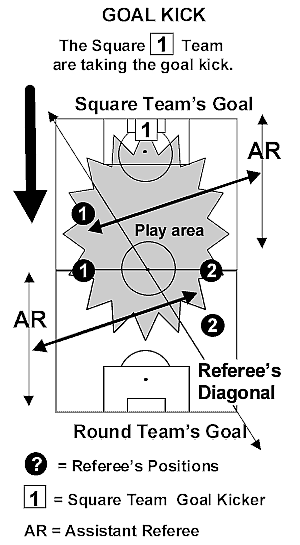

 |
+-+ BACK TO TOP +-+
+-+ FIFA-ADDITIONAL +-+
+-+ ADVICE from 'THE PITCH' +-+
Questions and Answers:
This web site and the advice and answers to any questions are not
sanctioned by or affiliated with any governing body of soccer. The
opinions expressed on this site should not be considered official
interpretations of the Laws of the Game. Although the content of the
latest Laws are included on this site, the majority of the content is
the opinion of the Webmaster and other Referees worldwide. If you need
an official ruling you should contact your local representative/association
or visit the FIFA, or the English FA web sites for the Laws themselves.
Questions and Answers:
Question 1: Before the ball
has left the penalty area during the taking of a goal kick - an opponent
strikes a defender. What action should the Referee take?
Answer 1: Stop play
immediately. Send off the opponent. Retake the goal kick - because the
ball had not come into play by leaving the penalty area when play was
stopped.
Question 2: During a goal
kick, the ball is accidentally kicked over the goal line inside the
penalty area. What action should the Referee take?
Answer 2: Retake the goal kick
- as the ball had not come into play by leaving the penalty area.
Question 3: Where does the
team awarded a goal kick have to place the ball, can they place it
anywhere they choose within the goal area?
Answer 3: The Laws used to
require that the goal kick be taken on the side of goal on which the
ball went out. This changed several years ago and players can place the
ball anywhere inside the goal area.
Question 4: What action
should the Referee take during a goal kick, if the ball just makes it to
the penalty area line and stops there?
Answer 4: The lines are part of
the penalty area; therefore a ball sitting on the line is actually still
within the penalty area and has therefore not come into play. The goal
kick should be retaken.
Question 5: If the ball fails
to clear the penalty area during the taking of a goal kick and the goal
kicker touches it again before it has left the penalty area - what
action should the Referee take?
Answer 5: So long as the ball
has not left the penalty area, it is simply not in play and players can
pick it up, stuff it under their shirt, balance it on their head,
whatever, with the only penalty being a retake of the goal kick, subject
to unsporting behavior and a repeated infringement of time wasting which
should be disciplined accordingly.
Question 6: When can the
kicking team's goalkeeper safely pick up a ball following a a goal kick
by his own team?
Answer 6: Only when the ball
has first passed completely out of the penalty area and has then been
touched by an opposing player can the goalkeeper safely pick it up. He
may not handle a ball, which has been intentionally kicked back to him
to him by a teammate. He may handle the ball if it is returned to him by
a teammate - but only if the pass/touch by the colleague was
unintentional.
Question 7: How far can a
ball be kicked during a goal kick?
Answer 7: In general, (so long
as it leaves the penalty area) it can be kicked as far as you want.
However, most tournaments that play six-a side for instance, as well as
most indoor football venues may stipulate other rules. Some even allow
the goalkeeper to throw the ball out during a goal kick.
Question 8: The Assistant
Referee has signaled for a goal kick but the Referee has awarded a
corner kick?
Answer 8: The actions of the
Assistant Referee are subject to the decision of the Referee. Regardless
of who was technically "correct", a corner kick would normally be
awarded - although it may be prudent to have a word with your Assistant
Referee beforehand. The Referee should listen to his Assistant Referee's
advice, and make a judgment accordingly. But the final decision lies is
the prerogative of the Referee.
Question 9: If a goalkeeper
(during the taking of a goal kick) kicks the ball directly up field to
an attacking colleague standing in an offside position in the opponent's
goal area at the other end of the field, and the attacking player
subsequently heads the ball into the opponents goal - is the goal legal,
or should this attacking player be penalized for being offside?
Answer 9: A player cannot be
offside if he receives the ball directly from a goal kick (or a throw-in
or a corner kick). In this instance, the ball did not touch any other
player and the attacker received it directly from the goal kick. The
attacker cannot be penalized for being offside direct from a goal kick,
and therefore the goal counts.
An attacking player in this position can of course be penalized for
offside if he receives the ball directly when his goalkeeper kicks the
ball from his hands or from a free kick.
It is sometimes difficult for an Assistant Referee who is watching for
offside, to ascertain if the Referee has given a direct free kick to the
defending team in their goal area at the other end of the field, or a
goal kick. If an attacking player in an offside position directly
receives the ball from a goal kick, then he should not be penalized for
being offside. Conversely, if the ball is directly received by an
offside attacking player from a free kick (taken in that attacking
player's own goal area) then he should be penalized for being offside.
In these instances (to help his Assistant Referees) the Referee should
use clear hand and arm signals to differentiate between a goal kick and
a free kick given in the goal areas.
Question 10: if a player
taking a goal kick intentionally plays the ball with his hand when the
ball has left the penalty area but before another player has touched it.
What is decision should the Referee make?
Answer 10: The Referee should
award a direct free kick to the opposing team, at the place where the
ball was handled.
Question 11: If a player
(other then the goalkeeper) takes a goal-kick and the ball passes out of
the penalty-area into play but is blown back into the penalty area by a
strong wind without any other player having touched it, and a player of
the defending side (other than the goalkeeper) plays the ball with his
hand within the penalty-area - should the Referee award a penalty-kick?
Answer 11: Yes, because as soon
as the ball leaves the penalty area during a goal kick, it comes into
play and normal rules apply (e.g. a penalty kick is awarded if a player
handles the ball in his own penalty area). If in similar circumstances,
the goalkeeper takes the goal-kick and tries to stop the ball entering
the goal and just touches the ball with his hand but fails to prevent it
passing into goal, the Referee should award an indirect free-kick.
Question 12: If a player is
intentionally tripped before the ball passes out of the penalty area
when a goal kick is being taken, should a free kick be awarded?
Answer 12: No, the ball is not
in play until it has been out of the penalty area. The offender shall be
cautioned or sent off and the goal kick should be retaken.
Question 13: After a goal
kick has been taken, the ball strikes the Referee inside the penalty
area and continues into play. Should the goal kick be retaken?
Answer 13: No. Any contact
between the ball and the Referee on the field of play is considered
irrelevant, and play should be allowed to continue. The Referee is part
of the field of play.
Question 14: At the taking of
a goal kick the ball is in the goal area but it is ROLLING when the
goalkeeper kicks it beyond the penalty area. Is the ball in play or not?
Answer 14: Albeit that Law 13
The Free kick clearly stipulates that the ball must be stationary when a
free kick is taken; as the question rightly implies, there is no such
written stipulation in Law 16 The Goal Kick (nor in Law 17 The Corner
Kick). And neither does it state that if the kick is taken when the ball
is NOT stationary, that the kick must be taken again. The only hint of
help given is the statement "For any other infringement of this Law, the
kick is retaken.
The requirement of a stationary ball during a goal kick and a corner
kick has been accepted and understood by all throughout the history of
football. The current England FA Basic Syllabus Part Two ‘ The Teaching
Notes’ used by Referee Instructors, does categorically state in its Law
16 & Law 17 notes, that the ball must be stationary. And this is where
new Referees will learn how these kicks are to be taken correctly.
Even though the Law does not exactly ‘spell it out’ - allowing a goal
kick or a corner kick to proceed whilst the ball is ‘rolling’ is
unacceptable. Why? – Because if you do, you will leave yourself open to
ridicule. There are two decisions you can make if the ball is rolling.
 -
1. Insist that the kick be retaken.
-
1. Insist that the kick be retaken.
 -
2. Allow the kick to proceed.
-
2. Allow the kick to proceed.
Notwithstanding the above, I believe that the omission of the statement
" The ball must be stationary when the kick is taken" should appear in
both Law 16 & 17.
|
